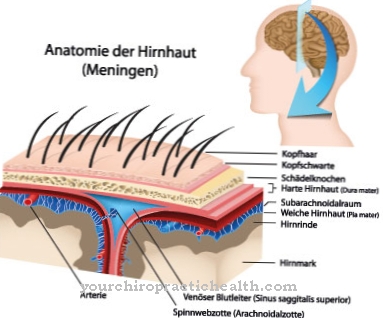The Corticobasal degeneration represents a disease that is counted among the so-called tauopathies. The disease is sometimes referred to by the abbreviation CBD. In the course of corticobasal degeneration, components of the tau protein are deposited in the human brain. As a result, the functioning of the brain is increasingly impaired over time. Basically, corticobasal degeneration is a so-called atypical Parkinson's syndrome.
What is Corticobasal Degeneration?

© andrey_orlov - stock.adobe.com
In principle, the typical symptoms can easily be confused with the Corticobasal degeneration and Parkinson's. In fact, corticobasal degeneration is a form of the atypical Parkinson's syndrome. These diseases are often confused with Parkinson's.
In addition, with regard to the frequency of atypical Parkinson's syndromes, corticobasal degeneration is in third place, after multiple system atrophy and progressive supranuclear palsy. Corticobasal degeneration usually develops over a long period of time.
It leads to continuously increasing damage to the brain and its function. For this reason, corticobasal degeneration is a so-called neurodegenerative disease. The tau protein accumulates in the brain, which is also known as tauopathy in medical terms.
The central symptoms are similar or correspond to the symptoms of Parkinson's. In addition, the cognitive abilities of the affected persons deteriorate increasingly. Basically, corticobasal degeneration is a relatively rare disease. According to the current state of knowledge, the frequency is 1: 100,000.
With regard to the characteristic symptoms, there are strong similarities to Parkinson's. However, some symptoms of corticobasal degeneration also indicate a dementia disorder. However, the causes of corticobasal degeneration are different from those of Parkinson's disease, which is why it is classified as an atypical Parkinson's syndrome.
causes
Basically, corticobasal degeneration is a relatively rare disease. According to medical research, the cause of the development of the disease lies in a special gene that is responsible for coding the so-called tau protein. The name of this gene is MAPT.
In the course of corticobasal degeneration, tau protein accumulates in the brain of the affected person. The protein is primarily deposited in the area of the so-called frontal lobe. In the course of the disease, these deposits in the brain cause complaints that are particularly related to the death of so-called glial cells and neurons.
Symptoms, ailments & signs
The corticobasal degeneration is associated with certain symptoms and complaints in the sick patient. For example, there is apraxia that is primarily related to the cerebral cortex. The cognitive performance of the affected person also decreases over time.
Ultimately, those affected will suffer from what is known as subcortical dementia. The corticobasal degeneration leads to an increase in the muscular reflexes, and myoclonus is also possible. The typical symptoms of the disease also include the fact that patients perceive their limbs as foreign and not part of the body. The English name for this phenomenon is 'alien limb'.
In addition, there are various motor disorders that also occur in Parkinson's disease. These complaints are often only one-sided at the beginning, for example hypokinesis or rigor. In a few cases, a so-called resting tremor occurs. In addition, dystonias are possible as part of corticobasal degeneration, which primarily affect the neck or the limbs.
Some patients experience significant gait disorder. In addition, some people have facultative symptoms. These include, for example, movement disorders of the eyes. Anxiety and depression occur especially when dementia develops.
Diagnosis & course of disease
The diagnosis of corticobasal degeneration is based on a fixed procedure. If a person shows symptoms typical of the condition, consulting a doctor is indicated. He or she will discuss the symptoms with the patient. In the course of clinical examinations, the suspicion of corticobasal degeneration grows stronger and stronger until a reliable diagnosis is finally made.
For example, histological laboratory tests of the brain are necessary. Imaging shows atrophy in the area of the cerebral cortex. So-called ballooned nerve cells also occur. The accumulations of the tau proteins can be determined with appropriate tissue examinations.
Complications
Corticobasal degeneration is one of the rare diseases that affect the functioning of the brain very quickly and severely. The reason for this is an increase in the components of the tau protein in the brain. This protein is preferably deposited in the area of the frontal lobe.
As a result of the deposits in the brain, various neurons and cells in the central nervous system become deserted in affected patients. The course is similar to that of Parkinson's disease. The complications caused by the neurodegenerative symptoms are serious. All of the affected person's cognitive abilities deteriorate as the symptom progresses. There is a general disorder of motor skills, especially running, movement disorders of the eyes and speech difficulties.
This is followed by a rapid increase in muscle reflexes and muscle twitching. In a short time, signs of subcortical dementia become noticeable. Due to the severe physical and mental degeneration, those affected react with depression and anxiety. In addition, the patient has the feeling of looking at their own limbs as foreign.
Corticobasal degeneration can only be detected by clinical procedures and imaging methods. There is currently no therapy against the symptom. It is limited to alleviating the suffering of those affected and maintaining the cognitive and mental abilities as far as possible. However, sick patients usually succumb to the symptom within a few years.
When should you go to the doctor?
If cramps and numbness are noticed in the muscles, the cause may be corticobal degeneration. An appointment with the family doctor is advisable if the symptoms increase and / or persist over a longer period of time. If the characteristic alien feeling develops in the muscles, medical advice is required. Signs of rigor or hypokinesis also require rapid clarification by the family doctor. Individuals diagnosed with corticobal degeneration should see a doctor regularly. The individual symptoms must be treated by different specialists.
Depending on the symptom complex, these can be, for example, neurologists, orthopedists and physiotherapists. Due to the severity of the illness and the expected negative prognosis, a psychologist should also be consulted. Even with a positive outcome, regular visits to the doctor are necessary, as new symptoms can develop again and again. In addition, the functioning of the brain tends to decrease, which is why a neurologist has to carry out appropriate brain exams on a regular basis. Externally, a corticobal degeneration is initially not visible. As the genetic disease progresses, poor posture and motor disorders can occur, which must be clarified by a doctor.
Treatment & Therapy
So far, there are no therapeutic measures that are able to stop the progression of corticobasal degeneration. Typically, most patients die about one to eight years after the disease is diagnosed. Healing options are not yet known.
In some cases, the drug levodopa improves symptoms that are similar to Parkinson's. Basically, the corticobasal degeneration proceeds in such a way that the affected patients suffer from increasingly severe disorders of the ability to move. This also leads to akinesia. Many people suffering from corticobasal degeneration ultimately die from inflammation of the lungs caused by the lack of exercise.
You can find your medication here
➔ Medicines to calm down and strengthen nervesOutlook & forecast
The prognosis for slowly but unstoppable corticobasal degeneration is poor. The symptoms of corticobasal degeneration are similar to those of Parkinson's syndrome. However, as they progress, they will be perceived as atypical Parkinson's symptoms. The cognitive abilities of those affected also increasingly decline. Your movements gradually slow down.
Corticobasal degeneration is genetically caused. It occurs very rarely. The medical professionals treat it as an atypical Parkinson's syndrome. So far, however, there are no effective and independent therapeutic approaches to alleviate the symptoms of the rarely occurring corticobasal degeneration. The disease progresses without any drug slowing or stopping it.
A characteristic feature for distinguishing corticobasal degeneration from Parkinson's disease is that those affected perceive their own extremities as not belonging to them. The increasing dementia and the variety of symptoms that occur increasingly worsen the prognosis.
There is no treatment option for corticobasal degeneration. At best, some people with Parkinson's symptoms can be improved somewhat with drug therapy. However, the drugs administered are often poor in this atypical Parkinson's disease.
The increasing movement disorders that occur make patients less and less mobile. As a result of increasing immobility, many sufferers die from pneumonia between one and ten years after the diagnosis.
prevention
According to the current state of medical knowledge, corticobasal degeneration cannot be prevented. Because the development of the disease is related to a genetic component over which the affected persons have no influence.
Aftercare
In most cases, the patient has only a few follow-up measures available for this disease. First and foremost, a quick and early diagnosis of the disease should be made in order to prevent further complications or complaints. As a rule, there is also no independent healing, so that the person affected should always consult a doctor if the symptoms of the disease are present.
The earlier the disease is recognized, the better the further course is usually. In most cases, the patients are dependent on the intake of various drugs. The doctor's instructions must always be followed, the correct dosage and regular intake must also be observed.
If you have any questions, or if you have any side effects, always consult a doctor first. Furthermore, those affected should protect their lungs particularly well, as this disease can often lead to inflammation. In most cases, the life expectancy of the person affected is severely limited due to the disease. It is not uncommon for loving and sensitive conversations with one's own family to be very important in order to prevent depression and other psychological complaints.
You can do that yourself
Self-help options are relatively limited in people with corticobasal degeneration. Those affected suffer from an enormous impairment of their quality of life and are no longer able to cope with everyday life independently. In particular, the rapid decline in cognitive performance and the disturbances in the motor area mean that patients with corticobasal degeneration are dependent on the help of other people for care and support.
Due to the difficulty in walking, patients are usually forced to use a wheelchair. In order to improve the quality of life, those affected adapt their home to the use of a wheelchair and redesign the facility. As a result, those affected still retain some of their independence. In addition, the patients perform physiotherapy with a physiotherapist and thereby improve their motor skills and fitness. Sports activities usually have a positive effect on the psychological and emotional state. However, these must be coordinated with a doctor and are also not able to completely stop the progression of corticobasal degeneration.
The corticobasal degeneration is still not curable, so that some of the patients suffer from anxiety attacks and depression, which are also caused by the serious physical changes.

.jpg)


.jpg)

.jpg)






.jpg)

.jpg)
.jpg)











.jpg)